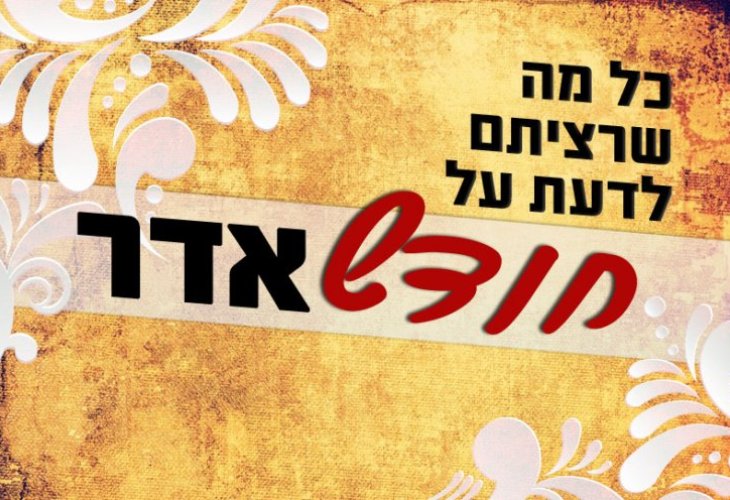Purim
Adar: A Month of Joy, Reversal, and Hidden Strength
The Final Month on the Torah Calendar Reminds Us That Salvation Can Emerge from Darkness
 Adar I Month of Adar
Adar I Month of AdarThe month of Adar is the sixth month from Creation and the twelfth and final month of the year on the Torah's calendar, which counts from the Exodus. The name Adar appears in the later books of the Bible, such as the Book of Esther, where it is described as “the twelfth month, which is the month of Adar” (Esther 3:7).
Like all other names of the Jewish months, Adar originates from Babylon. Some trace it to the Babylonian deity Adar. In Akkadian, a similar word means “darkness,” while in Ugaritic it signifies “strength.” In Babylonian Aramaic, Adar means threshing floor, as the season marked preparation for spring harvests. Others associate the name with the Hebrew root hadar, meaning splendor or beauty, reflecting the blooming fields and vibrant landscapes of the Land of Israel at this time of year.
Adar also appears as a personal name in the Book of Chronicles: “And the sons of Bela were Adar, Gera, and Abihud” (I Chronicles 8:3).
Adar always has twenty-nine days. However, in a leap year, which occurs seven times in a 19-year cycle, an extra month, Adar I, is added. In such years, Adar I always has thirty days, and Adar II always has twenty-nine.
 Adar I Month of Adar (Photo: shutterstock)
Adar I Month of Adar (Photo: shutterstock)Celebrations and Cosmic Signs
The holiday of Purim, commemorating the deliverance of the Jewish people from Haman’s decree, takes place in Adar. In leap years, Purim is celebrated in Adar II.
Four special Torah readings, known as the “Four Parshiyot,” are read in this season. The first is typically read on the last Shabbat of Shevat, and the other three usually fall in Adar. In some years, all four readings are read in Adar.
On the seventh of Adar, Moshe, leader and prophet of Israel, passed away. His successor, Joshua, led the people into the Land of Israel. In many communities, members of the Chevra Kadisha (burial society) fast on this day and visit cemeteries to make amends and seek forgiveness from those who passed away during the year.
Adar’s astrological sign is Pisces (the fish). Fish multiply in rivers and lakes during this season, and similarly, the fortunes of Israel begin to rise in Adar. Just as fish live in water, and water symbolizes Torah, so too the Jewish people are spiritually sustained by Torah. Fish also represent blessing and abundance, as they are hidden from view, and blessing abounds on those things that are hidden from view.
The plural form dagim (fish) also hints at the two Adars in leap years. Unlike the month of Av, which is considered unfavorable for Israel, Adar is seen as auspicious. As the sages say: “When Adar enters, we increase in joy.” They also teach that if someone has a legal dispute with a non-Jew, they should pursue it in Adar, when Israel’s fortunes are strong.
 Pisces
PiscesAdar in Chassidic Thought
Beyond the celebration of Purim, we should also reflect on the events that led to the holiday’s establishment by Mordechai and Esther. The Megillah recounts the events in detail: from the feast of Ahasuerus, to Haman’s decree, to the miraculous reversal of fate and the Jewish people’s triumph. These days are remembered and reenacted each year.
Chassidic teachings urge us to view this sequence not only as a historical record, but as a living guide. The events took place during what seemed like a successful time for the Jewish people: Mordechai was a leading scholar and royal advisor, Esther was queen of a vast empire. Yet despite these favorable circumstances, a decree was issued to annihilate every Jew. The sudden turn of events was shocking and inexplicable.
The sages explain that the cause was spiritual, not political. The Jews had enjoyed Ahasuerus’s non-kosher feast, and that spiritual misstep led to Divine judgment. The crisis did not stem from natural causes, nor could it be solved through diplomatic efforts or Esther’s royal position alone.
Mordechai understood that the root issue was spiritual. Instead of political lobbying, he called for fasting and repentance, widespread Torah learning, and a return to mitzvah (commandment) observance. Only after this spiritual repair did he turn to more conventional efforts.
The result was swift and extraordinary. Once the cause was addressed, the outcome changed. The Jewish people not only survived but emerged victorious: “The Jews had light and joy, gladness and honor” (Esther 8:16).
The lesson is enduring and clear: the Jewish people are not bound by the laws of nature. Success and salvation do not come from worldly strategies alone, which serve only as vessels for Divine blessing. Real transformation comes through strengthening Torah observance, and especially through Torah education for children, ensuring a deep and lasting connection to the chain of Jewish tradition.

